Summary of George Romney
Romney was one of the most popular English portrait painters of the late eighteenth century. He was a single-minded individual who rebounded from early career setbacks by producing a body of work to compete with Grand Manner greats such as Sir Joshua Reynolds and Thomas Gainsborough. Romney was nothing short of prolific, with his talents as a portraitist in great demand amongst all ranks, but especially with society figures who admired his ability to paint them with an honest charm. Today, Romney is perhaps best known for his numerous portraits of his muse, the enigmatic Lady Hamilton (who later achieved national fame and notoriety as the mistress of England's greatest maritime hero), who he transformed into incarnations of iconic figures from history.
Accomplishments
- When placed next to his rivals, Joshua Reynolds and Thomas Gainsborough, history has tended to assign Romney a secondary position within the late 18th century English School of portraiture (which, through what became known as the Grand Manner style, challenged the dominance of continental European art). While the reasons for this are manifold (Romney's career was, for instance, hampered by long bouts of depression and self-doubt) he still rose to the position of the era's most popular and coveted society portraitist. As his contemporary Henry Fuseli, put it, "He was made for the times, and the times were made for him".
- Romney's original ambition was to make his name as a history painter. His 1763 painting, The Death of General Wolfe, confirmed an early promise in the genre that was to never materialize. Having brought the young artist his first important award, the painting was subsequently attacked by influential establishment figures. In what now seems like a creative act of daring and imagination, Romney was in fact reproached for dressing a national hero (Wolfe) in contemporary costume, and for painting his skin with a deathly pallor. Those "criticisms" notwithstanding, The Death of General Wolfe would become a point of reference for future works on this topic, including those by the likes of Benjamin West (1770), and James Barry (1776).
- Romney helped immortalize his muse, Emma Hart (later, Lady Hamilton), through a series of theatrical poses depicting historical and mythological figures, such as Medea, Cleopatra, and Joan of Arc. Romney's portraits provided Hart with the springboard for her famous "Attitudes" recitals. Hart's Attitudes saw her bring her Romney portraits to life through a cycle of tableaux vivants ("living picture performances") which she staged for dignitaries in her new role as an ambassadress. Indeed, art historians such as Anthony Howell cite Hart's Attitudes as the "progenitor" to the modern performance art of the 1960s. Hart's Attitudes also anticipate and the theatrical historical role play of the major 1980s artist, Cindy Sherman.
- Romney produced a vast body of sketches and cartoons. Many of these embraced his keen interest in fantasy and Romantic literature, which at the time was at the cutting edge of English art. Later, Romney put his talents to more pressing concerns through his support for the work of the philanthropist and social reformer, John Howard. Romney produced a number of spontaneous and impassioned sketches that helped highlight the dreadful gaol conditions that Howard had exposed as part of a bigger movement towards widespread social and economic reform.
The Life of George Romney

Arts editor Kathleen Kuiper writes that "Romney avoided delving into the character or sensibilities of the sitter. His great success with his society patrons depended largely on just this ability for dispassionate flattery. Line rather than colour dominates; the flowing rhythms and easy poses of Roman classical sculpture underlie the smooth patterns of his compositions".
Important Art by George Romney
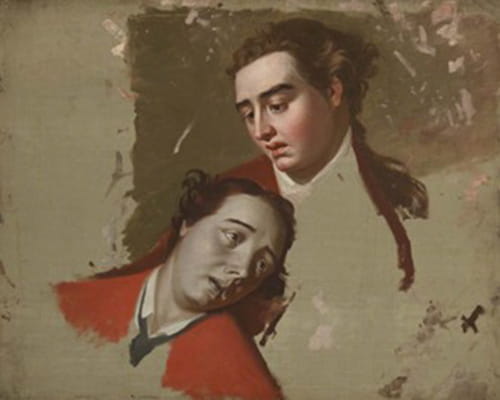
Study for the Death of General Wolfe at Quebec
In 1762, shortly after he moved from Northern England to London, Romney's history painting The Death of General Wolfe took second place in a competition at the Society of Arts. Unfortunately, the work has since been lost, following its purchase by a private collector and official of the East India Company, Harry Verelst, who took it to India, at which point its fate is unknown, and it is only known through word of mouth, and some preparatory sketches and painted studies, such as this, dated 1759. Wolfe had inspired a great deal of prose and poetry, immediately following his death, which was part of a larger story of the British army's triumphant victory at the Battle of Quebec, on September 13, 1759, which was a key moment in the Seven Years' War, and which solidified Britain's stronghold on the colonies in North America (keeping them from French control). Wolfe, who led the British army in the battle, immediately became a national hero, and Romney is believed to be the first artist to represent him in painting.
Romney had never met Wolfe, and visual sources on which to base his portrait were essentially non-existent. English arts professor Morton D. Paley writes that "Even Joseph Wilton, commissioned by the Duke of Richmond to do a bust of Wolfe [c. 1760], found it difficult to obtain a prototype: when Wilton had the general's coffin opened, the face had so deteriorated that he could not sketch it. The sculptor had to rely instead on the face of a servant who was said to look very much like Wolfe and on a line drawing by Wolfe's adjutant, Captain Hervey Smith. Romney may perhaps have approached Wilton for an opportunity to see one of Wilton's busts, as Wilton was co-director of the Duke of Richmond's sculpture gallery in which Romney sketched. His one certain visual source was J. S. C. Schaak's 'small whole length of General Wolfe' shown at the Free Society exhibition of 1762".
Paley explains that Romney's was "the first history painting - if we understand by this term the dramatic depiction of a heroic action - to dare to depict its subject in modern dress". Indeed, the painting "set a precedent for following treatments of its subject by Edward Penny [1763], Benjamin West [1770], and James Barry [1776]". At the time of the competition, Romney's decision to present the military leader in contemporary dress was considered controversial, and it is possibly the reason behind the reduction of Romney's prize money from fifty guineas to twenty-five (it is also possible that the decision was reached via Romney's arch rival, Sir Joshua Reynolds, who wielded great influence within the Society). Another issue with Romney's portrayal of Wolfe was, according to his friend, dramatist Richard Cumberland, "the deadly paleness of [Wolfe's] countenance". These criticisms notwithstanding, Paley notes that the painting "actually did very well for a young and virtually unknown artist exhibiting in London for the first time".
Oil on canvas - Lakeland Arts, Kirkland, Kendal, Cumbria, England
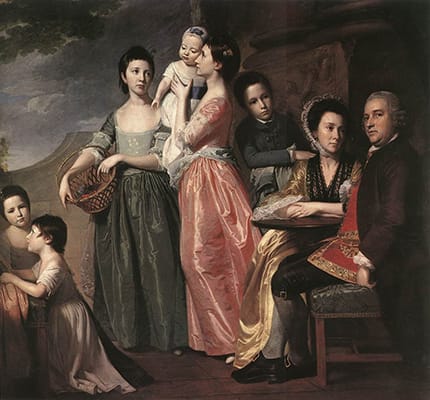
The Leigh Family
Romney produced a number of group portraits similar in style to those of eighteenth-century English artist Arthur Devis, who helped popularize group portraits known as "conversation pieces". These typically featured families or other groups of figures in pastoral outdoor settings, engaged in conversation, or other activities such as merrymaking or enjoying meals. Most conversation pieces were fairly modest in size. However, Romney's were much larger, often life-sized, as was the case with The Leigh Family, which features Mr. Jarret Leigh, a proctor in Doctors' Commons (Halls) and an amateur artist, with his wife and six children. Romney would gain a reputation for being especially adept at painting women and young children.
The other prominent portraitist to produce such large group portraits was Romney's rival, Sir Joshua Reynolds, and it seems that their works around this time were intended to upstage one another. The Leigh Family was very well-received when it was exhibited in 1768, and its success was likely due to its uniquely heroic portrayal of the family set against a neoclassical architectural background. However, it seems that Romney came to the realization that his Neoclassical designs could be greatly improved on by studying modern treatments of classical antiquity. This was likely the motivating factor behind his decision to travel to Italy where he learned first-hand from the great Renaissance masters.
Oil on canvas - National Gallery of Victoria, Australia
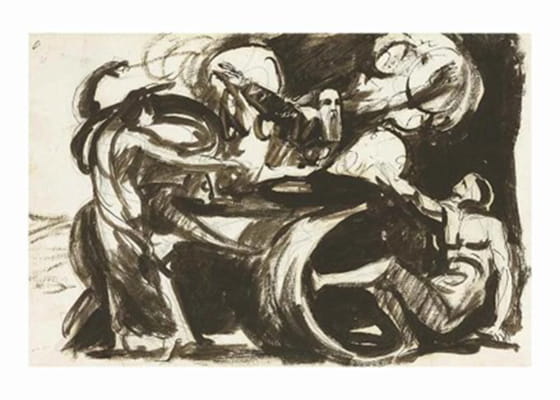
Atossa's Dream
This cartoon depicts a scene from the ancient Greek tragedy, The Persians, by Aeschylus. Atossa was an empress who anxiously awaits the return of her son, the Persian ruler Xerxes I, from his invasion of Greece (where the Persians were ultimately defeated). In the play, Atossa describes a dream in which a messenger tells her that her son and his army have failed, but that Xerxes has escaped and will return. Olga Taxidou, a professor of drama, performance studies, and Hellenic Studies, suggests that this part of the play was "probably the first dream sequence in European theatre". Atossa then visits the tombs of her deceased husband, Darius, King of the Persians, whom she summons from the afterlife, and who, like her, also decries the boy's over-confidence. Romney captures the scene in a swirling, billowing mass of figures, which, though difficult to interpret, does well to convey the drama of the moment, and the dream-state of the scene. Curator Alex Kidson explains that in Romney's image it is Xerxes who sits on the ground at the bottom right, fallen from his chariot, and extends his right arm toward the ghost of his father above. Meanwhile, writes Kidson, to the left, two "feminine figures symbolising the peoples of Greece (Graecia, in heroic pose with her arm raised in triumph) and Persia (Asia, in more craven pose) survey the scene".
Art Historian Anne Crookshank explains that "while [Romney] was in Rome he met [Henry] Fuseli who influenced him considerably. He helped to develop Romney's feeling for the weird and the supernatural, and probably introduced him to contemporary 'romantic' literature". British sculptor John Flaxman was a great admirer of Romney's drawings, once describing them as "examples of the sublime and terrible, at that time perfectly new in English art". Of Atossa's Dream, Flaxman commented that it was "conducted with the fire and severity of a Greek bas relief".
Crookshank notes that "It is seldom realized how many drawings George Romney made, and in what large quantities they have survived. [...] The majority of Romney's drawings are for subject pictures which were never carried out, while for his portraits there are comparatively few studies". Romney's son, John, noted that his father's cartoons "were executed in the winter evenings by candlelight as a relaxation when [his] mind had been jaded by portrait painting during the day". Romney destroyed many of his drawing before leaving for Paris, as he lacked the space in which to store them. The majority of those that survive are therefore forward of 1775, although some earlier drawings made while Romney was in Italy (including sketches of antique works, and illustrations of works by Shakespeare, Gray, Ossian, and Milton), also survive.
Pencil and brown ink, brown wash - National Museums Liverpool
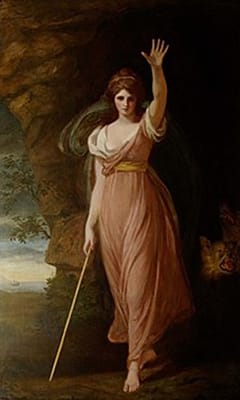
Emma Hart as Circe
This is an early painting of Romney's beloved muse Emma Hart. Referring to her as "the divine lady [...] superior to all womankind", they met in 1782, when she was just seventeen years old. The pair were introduced when the politician, Charles Francis Greville, who had taken Hart "into his care", brought her to the artist to sit for a portrait. Romney would go on to produce over sixty paintings, and close to 300 sketches, of Hart. He depicted her in a variety of poses, and very often dressed her up as historical and mythological figures such as Sibyl, Medea, Thetis, Mirth, Cassandra, Titania, and others. Here, he presents Hart as Circe, a minor Goddess in Greek mythology, who was the daughter of the Sun god Helios and the Oceanid nymph Perse. Circe was an enchantress with advanced knowledge of herbs and potions, and who used magic to turn her enemies into animals and monsters. Curator Alex Kidson argues that the painting marked a "decisive, intoxicating moment" at which "the difference between creative and routine portraiture crystalised in [Romney's] mind, and where the full expressive potential of the rapid sketch, immediate and poetic, became manifest to him".
In 1786 Romney was left bereft when his beloved muse left London (and Romney) for Italy. She travelled with Greville to Naples where he "duped her" (under a dubious financial agreement) into becoming the mistress of Greville's widowed uncle, Sir William Hamilton, the English ambassador to Naples. Hamilton had met Hart previously and he had been beguiled by her beauty and charm (so much so, in fact, he already had several portraits of Hart, by Romney, Joshua Reynolds and others, hanging on the walls of his palatial residence). The Royal Museums Greenwich writes that "In Hamilton's Naples home, Emma was surrounded by a wealth of beautiful, classical artefacts [...] She took lessons in languages, history, drawing, dancing and singing [and she] was present at regular dinners and events attended by the wealthy and influential. [It] was during these dinners that Emma's Attitudes were born". "Attitudes" was the name given to the tableaux vivants - "living picture enactments" - which Hart based on the mythical and historical figures she had embodied while modelling for Romney. According to historians Sophie Backman and Anthony Howell, Hart's Attitudes, which caused something of a sensation and became known across Europe, can be cited as the progenitor of Performance art. As they say, "[Hart] transformed the tableau vivant from a plastic to a theatrical visual art [and] embodied the spirit of the modern performance artist nearly 200 years before the 'happenings' of the 1960s". Backman and Howell refer here to the idea that Attitudes antedated an artform that was not object based (painting for instance) with the "happening" in question amounting rather to a unique (one-off) shared encounter between artist and her or his public. In a way, Hart's Attitudes anticipated the theatrical portraiture and self-conscious roleplaying as epitomized by American artist Cindy Sherman in the early 1980s.
London's National Portrait Gallery picks up the story of the Romney/Hart relationship five years after her initial departure for Naples: "... the unlikely marriage between a woman of 26 - who was deemed too 'vulgar' to be received at British court - and the 61 year old ambassador took place in London in 1791. With Emma's return, Romney was roused from his then habitual depression. He responded to his old subject with renewed vigour; he wrote excitedly to a friend 'The greatest part of this summer I shall be engaged on painting pictures from the divine lady.' In June and July, Romney commandeered her time for dozens of sittings, by August he had roughed in eight or nine further fancy pieces depicting Emma as a bacchante, as a Magdalen even as Joan of Arc. [However,] after 12 October the newly married Lady Emma Hamilton never sat for Romney again. Although Emma's presence in Romney's life had been a defining feature of his creativity, her [return to] Italy accentuated the chronic depression which he suffered from during the final, troubled and faltering, years of his career".
Oil on canvas - The Tate, London
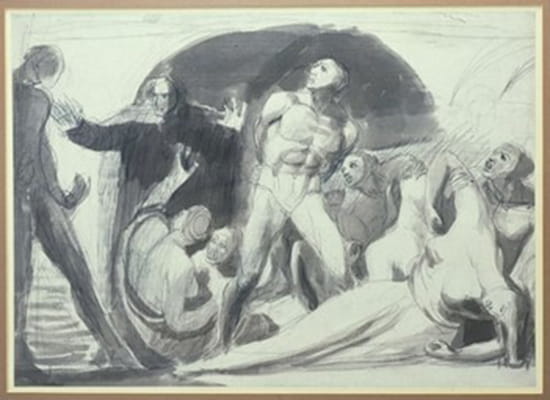
John Howard Visiting a Lazaretto
In the late eighteenth century, the philanthropist and social reformer, John Howard, devoted himself to the task of ridding disease from the penal systems in Britain and across Europe. He visited prisons and plague hospitals (lazarettos) and worked tirelessly for the human rights of prisoners and the incarcerated. His books, The State of the Prisons (1777), and The Lazarettos of Europe (1789), were powerful statements in the general move towards social reform. John Howard Visiting a Lazaretto is one of a group of works by Romney to support and celebrate the efforts of Howard. While Howard never sat for a Romney portrait, the drawings are now considered powerful historical statements in themselves.
Historian Nicholas Robbins writes, "Romney was one of the most successful portrait painters in Georgian London. His paintings were sought after for the healthful, prosperous glow they imparted to their subjects. The valuable, and unremarkable, quality of individuality found in his portraits emerged against the backdrop of the eighteenth century's radically unequal social world - and in private, Romney reflected upon this economic and social misery. [...] Romney's drawings - rapid, experimental, often enigmatic - which recorded the artist's ideas for these and other painting projects". The Abbot Hall Gallery adds, "Howard exposed the horrific conditions experienced during prison and hospital visits in his book 'The Lazarettos of Europe' [...] one year before the author himself succumbed to jail fever in the Ukraine. [In Romney's drawing] Howard is shown emerging from a dark arch, his hands held up in horror, as the jailer (far left) recoils in fear of his accuser. At the right a woman dies in the arms of a fellow prisoner; and, in the centre, others appear shackled and seemingly deranged as a result of their ordeals. The impassioned style of the drawing is typical of Romney's later works, but it is unclear as to whether the sketch was intended as a study for a painting".
Pen and ink over pencil - Abbot Hall Art Gallery, Kendal, Cumbria, UK
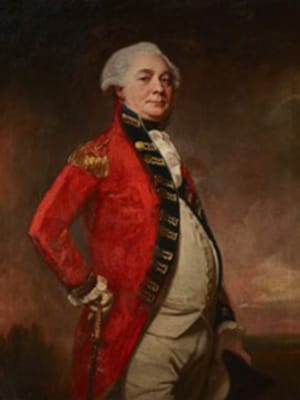
Portrait of Brigadier-General Lawrence Nilson
Brigadier-General Lawrence Nilson was an officer in the East India Company Bombay Army. In the portrait, Nilson is seen in three-quarter length pose, with his right arm bent, hand on hip, holding the hilt of a sword, while his left arm hangs down at his side -holding his hat near his thigh. He wears the red uniform of the Engineers' Regiment of the Bombay Residency. Romney's portraits usually featured romantic atmospheric backgrounds and here uses mottled red, grey, and black, to give the appearance of a storm brewing over a sea at twilight, intended to recall the sort of environment in which Nilson would have sailed. As was typical of Romantic-era art, the dramatic forces of nature present in the scene were linked with the turbulent drama men like Nilson faced as they made their way toward foreign enemies in faraway lands.
Curator Jon Sleigh has delved further into what he calls the "power paunch" in much eighteenth-century European portraiture, recognizing large stomachs on powerful men as a "potent, wealthy and aggressive visual form of male dominance". He writes, the subject "bristles with rigid authority as he stares back at us, his posture deliberate, self-aware and confident. Powdered hair, crisp white linen and opulent red regimentals frame a military man who dominates the canvas in erect pride. Humanism and sensory awareness are achieved by Romney in the face - red flushed cheeks demonstrate perhaps exertion, or more broadly the sitter's health. [...] The curve of the lower torso is captured vividly in the composition - neither the brigadier nor Romney make any effort to conceal the stomach. Far from it, the stomach arguably dominates the composition, pushed out towards us in aggressive prominence [...] Military aggression, imperial wealth, control, and by extension colonialism, plays out in the brigadier's physicality. Arguably, his stomach is visually as weaponised as the sword at his side".
Oil on canvas - National Trust, Springhill, Moneymore, Magherafelt, County Londonderry, Northern Ireland

Self-Portrait
In this, possibly the last of many self-portraits Romney painted in his life, the toll of physical exhaustion and a lifetime of poor mental health is evident in his expression. The backgrounds of Romney's portraits had always reflected a sort of psychological mindset associated with each subject, and here, the way in which the dark brown backdrop almost appears to swallow up the figure reflects the depths of depression into which he was falling. Romney's son John wrote of this work, "In the winter of 1795 he painted a head of himself, which, though slight, and not entirely finished, being painted at once, shews uncommon power of execution; the likeness also, is strong, but there is a certain expression of languor that indicates the approach of disease, which had in fact already begun to assail his constitution. It is remarkable that it is painted without spectacles, though he had been in the habit of using glasses for many years".
Art historian Charles Saumarez Smith notes, a similar gloominess and austerity can be found in Romney's earlier self-portraits, such as one dated 1784, in which "there is something about the way that Romney turns his head towards the spectator as if he didn't really want to be disturbed, with his body turned horizontally across the canvas, his slightly sardonic air, a hint of aggressiveness, of him looking out quizzically at the spectator, which has always struck me as setting Romney apart from his contemporaries, as if he did not wish to join the club, but appreciated his separateness". Smith notes that it was odd that Romney portrayed himself in such a manner in 1784, since, "looking at his circumstances, there was no real reason why he should not have been able to paint himself as a reasonably prosperous and successful painter at the height of his career". Smith concludes that this was most likely "simply a matter of temperament" with Romney often referred to in life as "anti-social," "in no way communicative," "shy," "private," "pensive," and "gloomy".
Oil on canvas - Metropolitan Museum of Art, New York
Biography of George Romney
Childhood
The son of cabinet-maker John Romney and his wife, Anne Simpson, George Romney was born in the Cumbrian village of Beckside, in the north-west of England. He was the third of eleven children (nine brothers and a sister). Sadly, only seven Romney siblings survived early childhood. Art historian David A. Cross explains that "George and his brothers grew up frail, in their psychological nature and physical constitution alike. [...] On the evidence of their father's somewhat erratic behaviour, it may be that the family's tendency both to creativity and to melancholia had a genetic source. Indeed, the artist himself believed that his tendency to fall 'into some melancholy malady' was 'partly constitutional'".
Education and Early Training
Romney was sent to school at nearby Dendron where his indifferent attitude to study led to him being withdrawn at the age of 11 and apprenticed to his father's business. By now, Romney had shown a natural ability for drawing and for crafting things from wood. He enjoyed drawing chalk portraits of local people on the workshop doors and copied woodcuts from Universal Magazine and other publications found in the libraries of his father and neighbors. When he was fifteen, he apprenticed with a local watchmaker named John Williamson, who Cross describes as "a man fascinated by mathematics and alchemy [who] explained to [Romney] the works of the camera obscura". Williamson also taught Romney to play and make violins. Says Cross, "In his maturity, Romney was to find that playing his instrument while surrounded by paintings helped him to resolve problems of composition".
For a time, Romney lodged with a family acquaintance named Mrs. Gardner, who was artistically inclined and enjoyed architectural drawing. She was impressed by the lad's talents and urged his father to find him a more accomplished tutor. In 1755, Romney moved to Kendal to apprentice with the portrait and genre painter, Christopher Steele who, although just one year Romney's senior, had the distinction of having studied with the French artist, Carlo Vanloo. Romney learned important practical skills in preparing and mixing colors, and compositional rules by completing many of Steele's works.
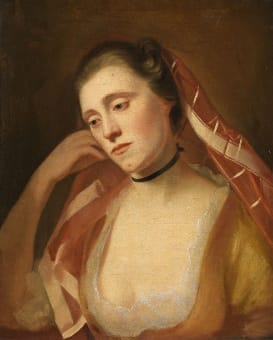
The physical and mental ailments that plagued Romney's childhood returned while working with Steele (who he was coming to resent for treating him more like an employee than a pupil). The daughter of Romney's landlady, Mary Abbot, helped nurse him back to full health. Romney was duly enticed into a romantic liaison with Mary, who was nine years his elder, and who soon fell pregnant with his child. The couple were wed on October 14, 1756, much to his parents' consternation. Romney regretted marrying Mary, but soon found respite when he was called away to York and Lancaster on business with Steele. in 1757, Steele cancelled the apprenticeship, and after briefly returning to Kendal to his wife and son (John), Romney travelled throughout northern England earning a few guineas at a time by painting small, full-length portraits. Around this time, he befriended the inventor and writer Adam Walker who sparked Romney's interest in the cosmos. In 1760, the Romneys had a daughter, Ann (who sadly died in 1763). But in March 1762, Romney parted from his family to seek his fortune in London, where he stayed (apart from the occasional return visit) until 1799. He maintained contact with his wife and child throughout, however, and provided financial support for them.
Mature Period
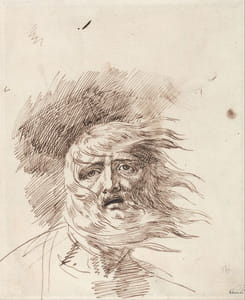
In the early 1760s, Romney, who was a devotee of William Shakespeare, produced a few experimental paintings exploring Shakespearian subjects, such as King Lear in the Tempest Tearing off his Robes (c. 1760). On March 21, 1762, he entered his history painting The Death of General Wolfe in a competition at the Society of Arts. The painting won second place, which came with a fifty-guinea prize. But, for reasons that were never confirmed, the prize was reduced to twenty-five guineas. Romney laid the blame firmly at the feet of Sir Joshua Reynolds, and his grievance aggravated the ill feeling between the two men.
History painting was where Romney's ambitions lay. Yet he was plagued by insecurity and self-doubt (no doubt exacerbated by the General Wolfe incident). According to Cross, "Romney was a person of quirky complexity, and his technical gifts were periodically hampered by 'singular infirmities of mind', which have led to him being inaccurately labelled as 'insane'. [...] Romney was aware of his own mental peculiarities. Following either frenzied displays of excitability or periods of gloom, he knew when he had offended others and would try to atone". Faced with the financial hardships of living in London, Romney abandoned his dream of becoming a history painter and pursued a more lucrative career as a portraitist.
In September 1764, Romney visited Paris for a few weeks with his friend, the lawyer Thomas Greene. During his short stay in the city, Romney found time to befriend the painter Claude-Joseph Vernet and to study the works of the Old Masters. Kuiper notes that, "Romney especially admired the work of Nicolas Le Sueur, whose use of the antique strongly appealed to him". In 1765, he again won the second-place prize (this time receiving the full prize money) in the Royal Society of Arts competition for, Death of King Edmund (now lost). In 1770, he began exhibiting his work at the Chartered Society of Artists, the rival society to the Free Society of Artists where he had previously exhibited (from 1763-69). In 1768 he also befriended the dramatist Richard Cumberland who was to have a positive effect on his career.
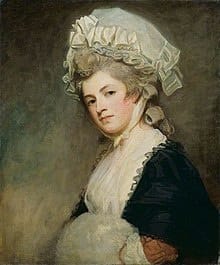
Despite his success, Romney was never invited, nor applied, to join the Royal Academy of Arts. Although he exhibited there periodically, his "non-membership" cost him royal patronage and the various connections that Academy membership would bring. While there has been much speculation about his ambivalence towards the Academy (usually centered on his grievances with the Academy's president, Reynolds) his often obstinate and aloof personality was based (in part at least) on his belief that a good artist would be able to succeed without the Academy's endorsement. (Towards the end of his life, however, Romney conceded that his obstinacy may have stymied his ability to reach his full potential).
In 1773 Romney travelled to Italy, making the outward journey with the miniaturist, Ozias Humphry, where he stayed for two years. A letter of introduction afforded him an audience with Pope Clement XIV who permitted Romney to erect scaffolds in the Vatican to study the fine detail in Raphael's Stanze frescoes. He also studied Titian's work in Venice, and Correggio's in Parma. While in Rome, Romney became a friend (and admirer) of the Swiss-English artist Henry Fuseli, who in turn, introduced him to the sculptor and fellow Royal Academician, John Flaxman.
Christies auction house writes, "having returned in 1775 from a formative two-year tour of Italy, Romney took the leasehold on Francis Cotes's house and studio at 24 Cavendish Square, and launched his career as a leading society portrait painter, in competition with Reynolds and Gainsborough". Romney was also favored as a portraitist due to the speed with which he worked.
Indeed, forward of 1775 he all-but stopped making preliminary sketches and painted directly onto canvas.
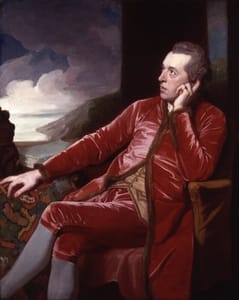
Romney's new success was due in large part to Cumberland, who having himself sat for a portrait, then introduced Romney to other influential patrons, such as politician Sir George Warren Romney, the Duke of Richmond, and the writer, William Hayley, with whom Romney built a lasting friendship. Yet in spite of his growing success, Romney was still not wealthy owing to his commitments to support his dissolute brother, Peter (an aspiring artist himself, who had fallen deep in debt), and the monies set aside to support his estranged wife and son.
Late Period and Death
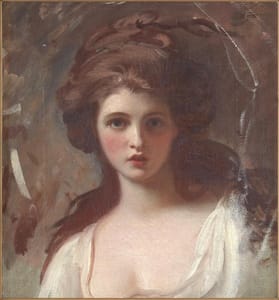
In 1782, Romney met the 17-year-old English maid, dancer, and actress, Emma Hart. Best known to history as the mistress of England's great naval hero, Lord Admiral Horatio Nelson, she would become Romney's muse, sitting for some 60 paintings and 300 sketches in total. For many of the paintings, Romney posed Hart as famous historical or mythological figures. However, In 1786 his beloved Emma left London and Romney for Italy where she became the mistress of Sir William Hamilton (preluding her relationship with Nelson), the English ambassador to Naples. Once settled in Naples, a resourceful Hart called on her experiences of posing as historical figures for Romney, to create a series of tableaux vivants, or "living picture performances". Hart's recitals became known as "Attitudes" which she performed for visiting dignitaries. Sotheby's auction house explains how "Using Romney's idea of combining classical poses with modern allure as the basis for her [Attitudes] act, she would pose wearing loose fitting garments modelled on those worn by Neapolitan peasants, accompanied by various shawls and veils. Emma soon became a sensation as she posed as various historical figures from antiquity, from Medea to Cleopatra, setting a new trend for Grecian inspired dress".
Romney also painted other women, including fellow artist, Mary Moser, and an unknown seventeen-year-old (Miss Constable) in, Miss Constable in a Bergère Hat (1787). Meanwhile, Romney had largely given up on his dream of becoming an important history painter. What works in this genre he did undertake rarely made it past the stage of sepia drawings. However, he did complete a massive Shakespearean shipwreck painting, The Tempest (1790), for engraver and publisher John Boydell, for his planned Shakespeare Gallery in London. Sadly for Romney, The Tempest was widely criticized for its crowded figures who, it was generally agreed, were poorly integrated into the composition (the painting was later destroyed in a fire). In 1791 Hart and Hamilton returned to London to be married. Hart posed for her last portraits with Romney before she returned to Naples in late 1791. It was the end of their relationship and her departure had a detrimental impact on Romney's already fragile mental wellbeing.
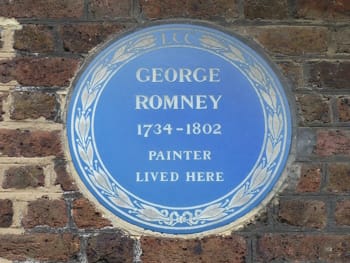
In 1797, Romney moved to Holly Bush Hill, in the affluent Hampstead neighborhood of London. He oversaw a significant amount of building work, and painted for up to eight hours a day, before ill health forced him to stop painting. It is believed that Romney's fragile mental health was aggravated by exhaustion, leading ultimately to a series of strokes. Possibly still heartbroken that Hart/Lady Hamilton had abandoned him - critic Jonathan Jones writes that "Romney's paintings of Hamilton are the masterpieces of a troubled, lonely man who was plainly obsessed with the young woman who gleefully tried on costumes and gestures in his studio. [and who] lives forever in his art" - Romney returned to his wife in Kendal in 1799. After nearly forty years of separation, she nursed him until his passing on November 15, 1802. Romney was buried at St. Mary's Parish Church in Dalton-in-Furness.
The Legacy of George Romney
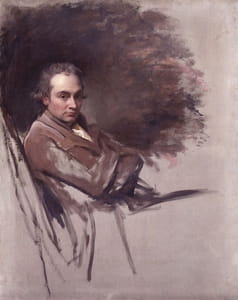
Romney was a leading English portrait artist of his time. Painting in the classically-inspired Grand Manner style, he was rivaled only by Sir Joshua Reynolds and Thomas Gainsborough. Artist and writer Arthur B. Chamberlain wrote in 1910, "[Romney was a] man of genius [who] succeeded with little aid except from his own natural gifts, into the front rank of the painters of his day". Chamberlain considered it a travesty that Romney's name was effectively forgotten after his passing. Romney's son, John, wrote in his biography of his father (1830) that "everything within the grasp of the human intellect, was an object of interest to his inquisitive mind," yet, sadly, he was limited throughout his life by the fact that "genius and [mental] infirmity too frequently go hand in hand".
Soon after his passing, Romney's friend and biographer, the dramatist Richard Cumberland, wrote in a letter (in the parlance of the day) to a friend:
"We were prepared for the Loss of Mr. Romney: in fact he was lost to us before his death. [...] He was an Extra ordinary man, For he owed nothing to Education, and his Art, like his genius, seem'd in him to be the Gift of Inspiration. I said we shall remember him for his Virtues, we have also to bewail his Failings and Infirmities. Elegant in his taste, and abstimious in his Habits, He was betray'd into Impurities, - which morality canott pardon, tho Candour may fairly plead that he kept his Weaknes out of sight, and never offended the Decorum of Society, or lost his Respect for virtue, tho' his practice did not strictly conform to it. To this we must impute the Irregularities of his Temper, the abstraction of his mind, and all those nervous and hypochondriacal affections, which sunk him in his own esteem, sapp'd his constitution, antisipated all the Symptoms of old age and finally struck him down into the Grave, a man worn out before his Time" (sic).
Influences and Connections

-
![Henry Fuseli]() Henry Fuseli
Henry Fuseli - Ozias Humphry
- Claude-Joseph Vernet
- John Flaxman
- Richard Cumberland
-
![Benjamin West]() Benjamin West
Benjamin West -
![Kehinde Wiley]() Kehinde Wiley
Kehinde Wiley - John Flaxman
- Edward Penny
- James Barry
-
![Henry Fuseli]() Henry Fuseli
Henry Fuseli - Ozias Humphry
- Claude-Joseph Vernet
- John Flaxman
- Richard Cumberland
-
![Romanticism]() Romanticism
Romanticism -
![Neoclassicism]() Neoclassicism
Neoclassicism - English School
Useful Resources on George Romney
- A Striking Likeness: The Life of George RomneyOur PickBy David A. Cross
- George RomneyBy Arthur Bensley Chamberlain
- Memoirs of the Life and Works of George RomneyBy John Romney
- George Romney: A Complete Catalogue of His PaintingsOur PickBy Alex Kidson
- George Romney, 1734-1802Our PickBy Alex Kidson
- George Romney: 215 PlatesBy Maria Peitcheva
- George Romney: Detailed DrawingsBy Narim Bender
- George Romney: Drawings & PaintingsBy Raya Yotova
- George Romney: His PaletteBy Arron Adams
 Ask The Art Story AI
Ask The Art Story AI










